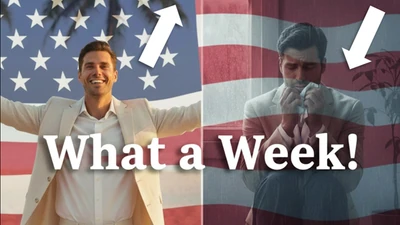As the summer of 2025 unfolds, the Israel-Iran conflict casts a shadow over global markets, stirring unease with its potential to disrupt oil flows and ignite inflation. Brent crude’s brief 13% surge to $78 per barrel and the S&P 500’s fleeting 1.1% dip on June 13 reflect a market on edge, yet quick to rebound as cooler heads prevail. For the intellectually astute conservative investor—rooted in principles of self-reliance, fiscal prudence, and a deep-seated skepticism of centralized overreach—this geopolitical storm is not a harbinger of doom but a call to strategic fortitude. The task is to shield wealth from volatility’s whims while seizing opportunities that resonate with free-market values and a vision for enduring prosperity. Here, I craft a roadmap, steeped in historical wisdom and tailored to the conservative ethos, to navigate the turbulence of the Israel-Iran conflict with clarity and conviction.
The Geopolitical Chessboard and Market Echoes
The Israel-Iran clash, though fiery, treads a familiar path. History teaches us that Middle East conflicts rarely unmoor markets for long unless they strangle global trade, as seen in the 1973 oil embargo’s crippling effect. The swift recovery of global indices by June 16, 2025, bolstered by OPEC’s spare capacity and minimal damage to Iran’s oil infrastructure, underscores this resilience. Yet, the specter of escalation—a potential blockade of the Strait of Hormuz, through which 20% of the world’s oil flows—looms as a wildcard, capable of thrusting prices past $100 per barrel and fanning inflationary flames. For the conservative investor, wary of government-fueled currency erosion and committed to free-market vitality, this moment demands a blend of caution and opportunism, balancing wealth preservation with calculated bets on conflict-driven sectors.
Fortifying Wealth with Timeless Safe Havens
The conservative investor, ever suspicious of fiat currency’s fragility, finds refuge in assets that stand firm against chaos. Gold, which glimmered with a 1.2% rise at the conflict’s peak, remains a steadfast hedge, its value proven through crises like the 1970s stagflation. Its tangible allure aligns with a worldview that distrusts centralized financial systems. Complement this with U.S. Treasury bonds, particularly short- to medium-term notes, which offer safety and yield as the Federal Reserve holds rates steady amid oil-driven price pressures. By allocating 5-10% of your portfolio to the SPDR Gold Shares ETF (GLD) for liquidity and the iShares 7-10 Year Treasury Bond ETF (IEF) for steady income, you erect a bulwark against volatility, honoring the conservative imperative to preserve capital without bowing to the caprices of central bankers.
Embracing the Resilience of Dividend Stalwarts
When markets quiver, the temptation to flee grows strong, but the conservative investor, anchored by discipline, turns to companies that endure. Dividend Aristocrats—titans like Procter & Gamble and Johnson & Johnson, which have raised payouts for over 25 years—deliver reliable cash flows and lower volatility than their tech-heavy peers. A 2023 Morningstar study affirms their mettle, showing 8-10% annualized returns with reduced downside risk, a beacon for those who prize stability. The Schwab U.S. Dividend Equity ETF (SCHD), with its miserly 0.06% expense ratio, offers exposure to these stalwarts, rewarding firms that prioritize shareholders over speculative gambits. By weaving such assets into your portfolio, you embody the conservative virtue of patience, building wealth that withstands geopolitical tremors.
Seizing Free-Market Opportunities in Energy and Defense
The Israel-Iran conflict shines a spotlight on sectors dear to the conservative heart: energy and defense. Rising oil prices fuel profits for producers like ExxonMobil, while defense firms like Lockheed Martin, buoyed by a 2-3% rally in European counterparts, thrive on heightened security demands. These industries, less entangled in government subsidies than their renewable rivals, resonate with a worldview that champions free-market resilience and national sovereignty. By allocating 10-15% of your portfolio to the Energy Select Sector SPDR Fund (XLE) and the iShares U.S. Aerospace & Defense ETF (ITA), you position yourself to profit from conflict-driven tailwinds while supporting sectors vital to American strength—a nod to your expressed interest in energy and defense as bulwarks of stability.
Mastering Volatility with Disciplined Averaging
Market dips, like the S&P 500’s brief stumble, tempt emotional overreactions, but the conservative investor knows better. Dollar-cost averaging—investing fixed sums regularly—tames volatility by capturing more shares at lower prices. Historical patterns, such as the market’s three-week recovery after the 1990 Gulf War’s 6% drop, affirm this approach’s wisdom. Automating monthly contributions to the Vanguard S&P 500 ETF (VOO) ensures you buy the dip without succumbing to panic, a strategy that mirrors the conservative ethos of steadfastness over impulsivity. This disciplined rhythm transforms volatility from foe to friend, building wealth through market cycles.
Shielding Against Inflation’s Creep
With oil price spikes threatening to add 0.4% to consumer prices for every 10% rise, inflation looms as a specter, particularly for conservatives wary of government spending’s erosive effects. Real assets offer a shield: Real Estate Investment Trusts (REITs) provide income and inflation protection, while Treasury Inflation-Protected Securities (TIPS) adjust principal to match price increases. The Vanguard Real Estate ETF (VNQ) delivers diversified exposure to property, and the iShares TIPS Bond ETF (TIP) safeguards purchasing power. By weaving these into your portfolio, you counter inflation’s stealthy advance, aligning with a conservative commitment to preserving wealth’s real value.
The Conservative Edge: Principle Meets Pragmatism
The Israel-Iran conflict, while unsettling, is a storm the astute conservative investor can navigate with aplomb. Gold and Treasuries anchor your portfolio, embodying the quest for stability. Dividend Aristocrats and dollar-cost averaging reflect the discipline of self-reliance, while energy and defense investments capture free-market opportunities, echoing your interest in national resilience. Real assets guard against inflation, a perennial conservative concern amid fiscal profligacy. Together, these strategies form a citadel of resilience, blending intellectual rigor with principled conviction.
Charting the Course Ahead
Construct a portfolio that balances defense and offense: 50% in broad-market ETFs like VOO for growth, 20% in dividend-focused SCHD for income, 10% in gold via GLD, 10% in Treasuries through IEF, 5% in energy with XLE, and 5% in defense via ITA. Adjust these weights to match your risk tolerance and horizon. Keep a vigilant eye on the Strait of Hormuz and U.S. military involvement, which could escalate oil prices and inflation, roiling markets. Shun speculative fads—cryptocurrencies or meme stocks—that clash with your skepticism of hype. Embrace tax-advantaged accounts like Roth IRAs to minimize fiscal burdens, a hallmark of conservative prudence.
As the Middle East simmers, the conservative investor’s credo endures: prepare, don’t predict. With a blend of caution and cunning, you can not only weather this geopolitical tempest but emerge stronger, your wealth fortified and your principles intact.










